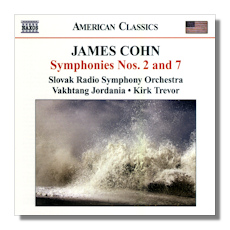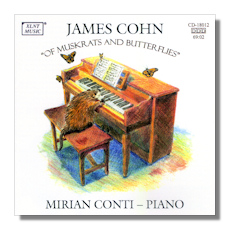
The Internet's Premier Classical Music Source
Related Links
- Cohn Reviews
- Latest Reviews
- More Reviews
-
By Composer
-
Collections
DVD & Blu-ray
Books
Concert Reviews
Articles/Interviews
Software
Audio
Search Amazon
Recommended Links
Site News
 CD Review
CD Review
James Cohn

Symphonies & Piano Music
- Symphony #7, Op. 45 (1967) 27:46 *
- Symphony #2, Op. 13 (1949) 22:16 **
- Variations on "The Wayfaring Stranger", Op. 34 (1960) 11:28 *
- Waltz in D Major, Op. 29a (Orch. 1962) 4:01 **
* Slovak Radio Symphony Orchestra/Vakhtang Jordania
** Slovak Radio Symphony Orchestra/Kirk Trevor
Recorded 2001; released 2008
Naxos American Classics 8.559376 65:53


Of Muskrats and Butterflies
- Miniatures (16:08)
- Variations on "Muskrat Ramble" (3:07)
- Piano Sonata #2 (11:25)
- Piano Sonata #5 (8:50)
- Americana (5:15)
- Waltz in D Major (4:26)
- Strutting Butterflies (1:33)
- Concerto for Piano & Orchestra (14:27) *
Mirian Conti, piano
* Latvian Symphony Orchestra/Vakhtang Jordania
XLNT CD-18012 69:02
James Cohn's (b. 1928) particular creative strengths are in his gifts for rhythm and orchestration, such that his orchestral works are engaging and his piano music delightful. In style he has not exactly been in sync with his times, which is not something I personally have a problem with, but which no doubt helps to explain why he is not better known. For the most part his music is quite tonal, for one thing. Another reason for his relative obscurity is that he has, I believe, spent much of his career writing music for cinema and television – generally not high-profile venues. It is gratifying that Naxos is now, when he is eighty, giving him better recognition through its American Classics series.
The major work here is his Symphony #7, which is neoclassical in style. In fact, the opening Allegro giusto, in its melodic angularity and staccato rhythms, often with the beat at the end of a phrase is quite reminiscent of Stravinsky's symphonies. I'm not in the least inclined to say that of the beautiful, and beautifully orchestrated, Andante cantabile which follows. I hear it as a musical conversation with different voices alternating and at one point becoming intense. The Allegretto energetico seems to combine the approaches of the previous movements, with contrasting vigor and gentleness suggestive perhaps of concerto grosso's manner of contrasting groups of players, though for full orchestra. One only wishes that Cohn would have varied the main theme more, but he describes it as "alternating between a deadpan formality and semi-hysteria." The finale, Molto presto e precipitato certainly begins in the character suggested in Italian, but the manner and pace varies later, again in a kind of conversation with a bit of drama to it. The music breathes and the forces range from light and soft strings to drums and brass. Cohn describes the finale as "a rondo with a driving insistent melody, occasionally relieved by short, cryptic but lighthearted statements."
The Symphony #2 was a student work, presented as Cohn's graduation piece at Julliard, where he studied with Bernard Wagenaar. (He also studied with Roy Harris and Wayne Barlow, who in turn studied with both Schoenberg and Hanson.) It happened to win him a Queen Elizabeth of Belgium award as well as his degree. Already, at the age of 20 or 21 Cohn was a consummate orchestrator, especially in his use of the woodwinds. He describes his opening Allegro risoluto as "by turns, both defiant and reflective." I would have characterized it as displaying alternately vigor and sweetness. The second scherzo movement, Presto, has pounding, driving chords but with its significant pauses and expressive woodwind solos it is hardly headlong; Cohn speaks of "obsessive driving figurations and short jazzy passages." The Andante con moto is based on a serial row but meant to be "emotionally expressive, alternating between sad, moody and passionate exclamations." The finale, Allegro marcato, is a rondo, with notable use of woodwinds and drums.
Variations on "The Wayfaring Stranger" (a southern folksong) was written in memory of his friends, a couple who died within weeks of one another. It begins with a long theme played by the oboe and there are twelve contrasting variations at different tempi and rhythms. Appealing solos for violin, flute, clarinet, bassoon, and trumpet are also heard as well as the basses and full orchestra.
The Waltz in D, originally scored for brass octet and then solo piano, eventually became a work for symphony orchestra. It contains some strong but unexpected beats of the sort Prokofiev might have appreciated and makes a very different impression from the piano version.
The sound on the Naxos disc leaves nothing to be desired, to my ears on my equipment. I am happy to give this release a strong recommendation.
Cohn's piano music on the XLNT release is very different from the orchestral music, except that as I suggested it is also characterized by strong rhythms. It is generally unpretentious, playful, often whimsical and even waggish, as some of the titles suggest. Butterflies don't strut, except in a private reverie, for instance. One of the Miniatures is called "Boogie." The fifth sonata is subtitled "a slightly 'Blue' Sonata" and "has elements of "blues" and "boogie-woogie," in addition to other unexpected features." Cohn thinks that a 20th-century Josef Haydn might have written for the keyboard like this. Other works have elements of jazz and tango. This is not "earnest" music, not even the concerto and sonatas. Listening to it I was sometimes reminded, especially by Muskrat Ramble, of the rags of Judith Zaimont and, like those, these pieces are quite enjoyable if taken in the spirit they were intended.
Most of these piano works were written on commission for two pianists: Maryla Jonas, who did not live long enough to play the second sonata. The Argentine-American Mirian Conti who plays a Steinway Hamburg D Concert Grand on this recording, performs all these pieces very well and very idiomatically.
The nine Miniatures grew out of a request for a little "Music Box" piece. They are in different styles. The first, "Sunrise," is gentle nut is followed by "Boogie" and a piece that sounds like a Russian dance. Parade is appealingly jaunty.
Variations on Muskrat Ramble has origins in a Dixieland march but morphs into various forms including a tango. Americana is based on two traditional American songs.
Neither piano sonata nor the recent piano concerto is very lengthy. The second sonata opens quietly; it is mildly jazzy and takes a stronger cast toward the end of the movement which, like the slow movement following is rather meditative. The fast finale is the most interesting of the three movements, having more complexity and vigor. Sonata 5 has very short first and last movements, with jazzy and rag-like character. The longer middle movement is less interesting.
The concerto has a fast, slow, fast construction like the sonatas. The first movement is bouncy and lively. The second is quiet and relaxing with a recurring old time melody. The finale opens in a thumping manner and then seems to skip along merrily. The playing is fresh and vigorous.
The works on this disc are not identified by date or opus number, and the movements of the sonatas and concerto are not given tempo descriptions.
The disc will surely give pleasure to those who find this style of music appealing.
Copyright © 2009, R. James Tobin





















